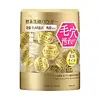What's inside
What's inside
 Key Ingredients
Key Ingredients

 Benefits
Benefits

 Concerns
Concerns

 Ingredients Side-by-side
Ingredients Side-by-side

Talc
AbrasiveMaltitol
HumectantSodium Cocoyl Isethionate
CleansingSodium Myristoyl Glutamate
CleansingSodium Lauroyl Glutamate
Sodium C14-16 Olefin Sulfonate
CleansingPotassium Laurate
EmulsifyingCarrageenan
Glycyrrhiza Glabra Root Extract
BleachingSqualane
EmollientCitric Acid
BufferingSodium Hyaluronate
HumectantHelianthus Annuus Seed Oil
EmollientPersea Gratissima Oil
Skin ConditioningBHT
AntioxidantDipropylene Glycol
HumectantSilk
Ethyl Glucoside
HumectantProtease
ExfoliatingLipase
Skin ConditioningSodium Benzoate
MaskingTalc, Maltitol, Sodium Cocoyl Isethionate, Sodium Myristoyl Glutamate, Sodium Lauroyl Glutamate, Sodium C14-16 Olefin Sulfonate, Potassium Laurate, Carrageenan, Glycyrrhiza Glabra Root Extract, Squalane, Citric Acid, Sodium Hyaluronate, Helianthus Annuus Seed Oil, Persea Gratissima Oil, BHT, Dipropylene Glycol, Silk, Ethyl Glucoside, Protease, Lipase, Sodium Benzoate
Talc
AbrasiveSodium Cocoyl Isethionate
CleansingSodium C12-14 Olefin Sulfonate
CleansingSodium Lauroyl Glutamate
Sodium Myristoyl Glutamate
CleansingPotassium Laurate
EmulsifyingCarrageenan
Silk Powder
Skin ConditioningWater
Skin ConditioningMethicone
EmollientButylene Glycol
HumectantIsostearyl Alcohol
EmollientBHT
AntioxidantAlcohol
AntimicrobialPolyquaternium-51
Skin ConditioningLactobacillus/Soymilk Ferment Filtrate
Skin ConditioningNasturtium Officinale Extract
PerfumingLactic Acid
BufferingPotassium Hydroxide
BufferingProtease
ExfoliatingLipase
Skin ConditioningMethylparaben
PreservativePhenoxyethanol
PreservativeTalc, Sodium Cocoyl Isethionate, Sodium C12-14 Olefin Sulfonate, Sodium Lauroyl Glutamate, Sodium Myristoyl Glutamate, Potassium Laurate, Carrageenan, Silk Powder, Water, Methicone, Butylene Glycol, Isostearyl Alcohol, BHT, Alcohol, Polyquaternium-51, Lactobacillus/Soymilk Ferment Filtrate, Nasturtium Officinale Extract, Lactic Acid, Potassium Hydroxide, Protease, Lipase, Methylparaben, Phenoxyethanol
Ingredients Explained
These ingredients are found in both products.
Ingredients higher up in an ingredient list are typically present in a larger amount.
BHT is a synthetic antioxidant and preservative.
As an antioxidant, it helps your body fight off free-radicals. Free-radicals are molecules that may damage your skin cells.
As a preservative, it is used to stabilize products and prevent them from degrading. Specifically, BHT prevents degradation from oxidation.
The concerns related to BHT come from oral studies; this ingredient is currently allowed for use by both the FDA and EU.
However, it was recently restricted for use in the UK as of April 2024.
Learn more about BHTCarrageenan comes from red seaweed or algae. It is made up of polysaccharides and a highly flexible compound. Red algae cell walls are rich in carrageenan.
In cosmetics, it helps to thicken the texture. Studies show carrageenan extracted from red algae possess antioxidant properties. Components found in carrageenan include: lipids, fatty acids, Vitamin E, proteins, and several amino acids.
Learn more about different types of algae.
Carrageenan is also commonly used in medicine and food. It is a vegan alternative to animal-based gelatin.
Learn more about CarrageenanWe don't have a description for Lipase yet.
We don't have a description for Potassium Laurate yet.
These enzymes break down protein into smaller peptides and amino acids. They also encourage the formation of new protein.
Our skin uses peptides, amino acids, and protein for maintaining healthy skin cells.
Protease work by breaking peptide bonds in protein with hydrolysis. This is the process of breaking bonds using water.
An in-vitro study (not done on a living organism) found a blend of 3-protease decreases skin inflammation by mitigating the effects of other proteins.
One manufacturer that uses subtilisin, a protease from Bacillus subtilis, claims this ingredient is exfoliating, promotes cell regeneration, and is a good substitute for AHAs. Further research is needed to back up these claims.
Fun fact: The human body contains ~641 protease genes.
Learn more about ProteaseSodium cocoyl isethionate is a natural ingredient from coconut oil. It is an ultra gentle cleanser that gives a nice foam without drying the skin or impacting the skin barrier.
The amount of foam created depends on the amount of sodium cocoyl isethionate used in the product.
This ingredient also helps improve the spreadability of a product.
Learn more about Sodium Cocoyl IsethionateSodium Lauroyl Glutamate is the sodium salt from the lauric acid of glutamic acid.
It is a surfactant and helps cleanse the skin. Surfactants gather oil, dirt, and other pollutants from your skin so they may be washed away easily.
We don't have a description for Sodium Myristoyl Glutamate yet.
Talc is a clay mineral. It helps absorb moisture and improve the texture of products. Like other types of clay, Talc can have a slight exfoliating effect on skin. Talc can be added to increase the volume of products.
Some Baby powders are made by combining talc with corn starch. The word "talc" comes from Latin and originates from Arabic. Talc is a mineral commonly found throughout the world.
If you have any concerns about using talc, we recommend checking out the FDA's official page.
Learn more about Talc